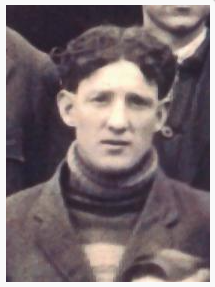
109630 Pte. Albert Victor Stuart was born on 16th July, 1889, in Toronto, Ontario, to Thomas and Harriet Stuart.
Shortly after he was born, the family, now with 5 children in tow, moved to Woodstock, Ontario, where they would have 2 more children and then eventually settle in Brantford, Ontario, where they had a further 5 children.
Albert Stuart, by now a coremaker handling castings at the Goold, Shapley and Muir Com. steel mill in Brantford, and having seen some previous military experience in the Militia before the war, enlisted on 27th November, 1914, in Toronto. He was immediately assigned to 'B' Company of the 4th CMR. Four of his brothers enlisted with other regiments.
After enduring training through a particularly harsh Toronto winter, the 4th CMR were moved on to Niagara-on-the-Lake for continued training in May 1915. From there, in June, they were sent to Valcartier, coming together with the 5th and 6th CMRs to form the 2nd Canadian Mounted Brigade. Then on July 18th they boarded the SS Hesperian in Quebec and commenced their journey to the European theatre of war.
Arriving at Plymouth, England, on July 29th, they travelled on to Shorncliffe, Kent, which would be their home and training base until October 1915. After extensive training they boarded a train on October 25th, which took them to the port of Southampton, where they sailed to France, landing in La Havre the same day. On October 26th they boarded another train, which took them to Bailleul, where they marched to billets within earshot of the guns pounding away around Ypres, Belgium, 16km / 10 miles to the north-east. They had arrived!
On November 23rd, 1915, they took up front line positions in the trenches for the first time, close to Hill 63, near the Belgian town of Ploegsteert [affectionately known as the easier to pronounce "Plugstreet" by British Tommies - and also site of the infamous soccer matches between both sides during the extraordinary "Christmas Truce" the previous year].
They served admirably through the winter of 1915 into 1916 [no truces in their area, but some minor ones did happen elsewhere], and in the June of 1916 found themselves positioned in front line trenches in front of Armagh Wood, south-east of Ypres. On the morning of the 2nd, the Germans opened up a fierce barrage, the likes of which had not been seen to that date. For five long hours the trenches occupied by the 4th CMR, with the 1st CMR to their left and the 5th Battalion Canadian Infantry to their right, where mercilessly pounded until tilled flat. When the rain of steel and high explosives finally stopped, two mines were detonated under their positions. 192 men were lost that day, though when the German troops walked over they still managed to take 350 prisoners of those who were injured or who had somehow managed to survive the onslaught. It was a dark day for the regiment.
Albert, taken as one of the POWs, received an arm and "slight" head wound in the attack, though his records report this as a gunshot wound near his left eye. However, his wounds actually required three months of hospital attention. He was initially taken to Dulmen in Germany, but was transferred to Minden later in the month and then in July was moved on to Münster. He was moved to Friedricksfeld in April 1917, and was variously shuffled between there and Minden for the remainder of the war. He reported in a letter home that he was being looked after well by his captors when he was sick. Clearly this was for home consumption, to stop them worrying, and to appease the censorship his letters would have been subjected to. In reality he was often bordering on starvation as their food parcels were not getting through, and he suffered ill-health having had to work down the coal mines and endure hardships and harsh sentencing for escape attempts and misdemeanours in refusing to work or striking guards. He lost a lot of weight, having been at 164 lbs / 74kg when he signed on. He was 127 lbs / 57kg when assessed after his release. During captivity he&39;d, not surprisingly, developed a nervous condition. Despite the decline in his health, it seems Albert made three attempts to escape the POW camps. On one of these occasions he'd made it to within 200 metres of the Dutch border!
Released a few days after the cease of hostilities, Albert was repatriated back to England and arrived in Ripon, Yorkshire, on 30th November 1918. He underwent medical attention and eventually was sent back to Canada on 24th January 1919.
Having been transferred to the 25th BN for administrative purposes, Albert was officially discharged in Toronto as medically unfit for further service. He was demobilised on 20th February, 1919. Sadly, of the five serving Stuart brothers, one did not make it home.
Returning to normal life, Albert took a bride, Maude Madeline Walton, on 13th October 1919, when they married in Hamilton, Ontario.
He and his new bride subsequently become US Citizens, living in Detroit, where Albert worked for Chrysler.
Albert Victor Stuart passed away on 15th May 1947 and lies at rest in Mount Hope Cemetery, Brantford, Ontario.
Credit and many thanks go to Jennifer Stuart-Jessel for the above image and biography of her great uncle. Additional service details added by 4cmr.com
Please do visit the Great War Centenary Association's website via this link for further details of Albert's story, particularly for sight of trascriptions of those letters he wrote home, and for newspaper reports concerning his captivity and eventual return back to Canada.